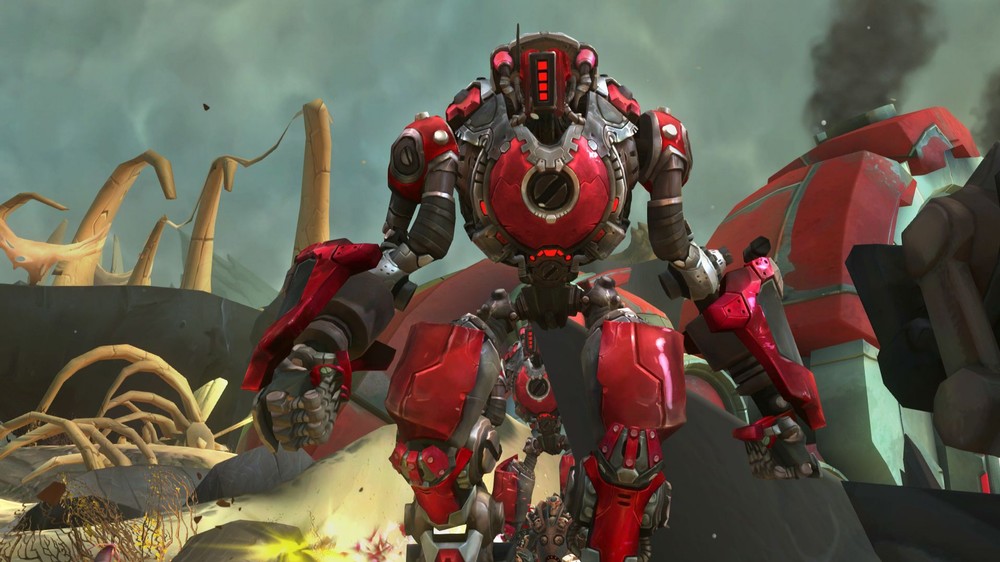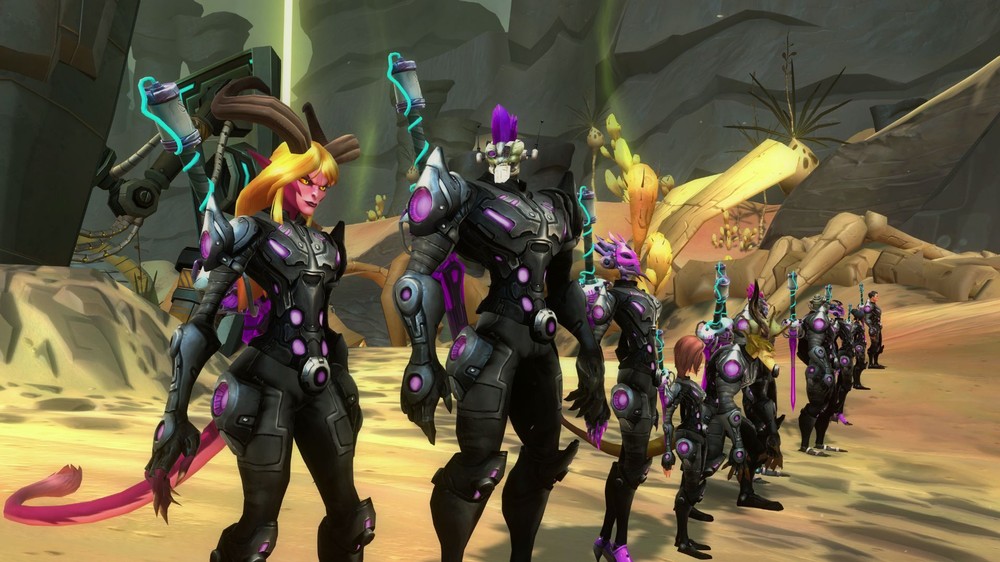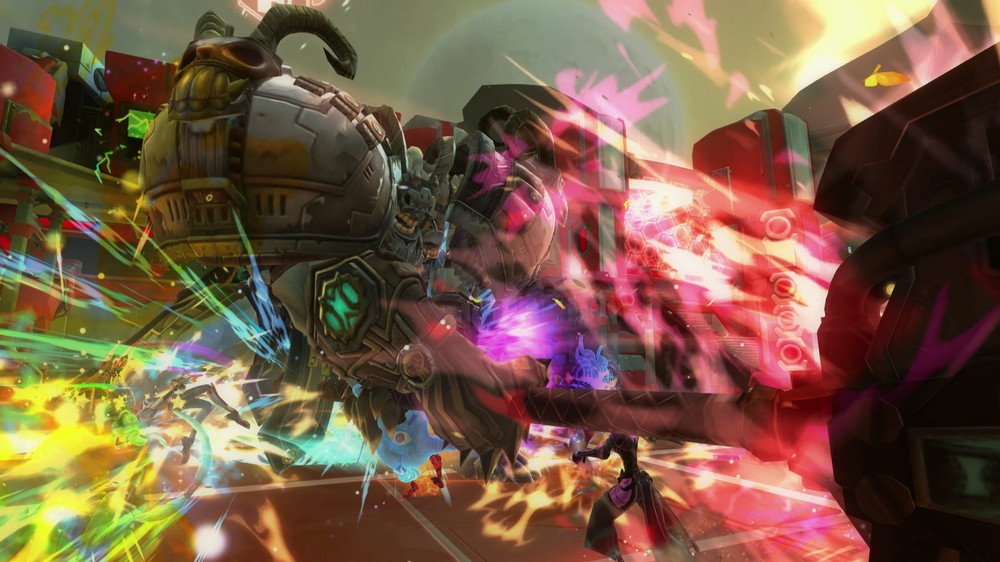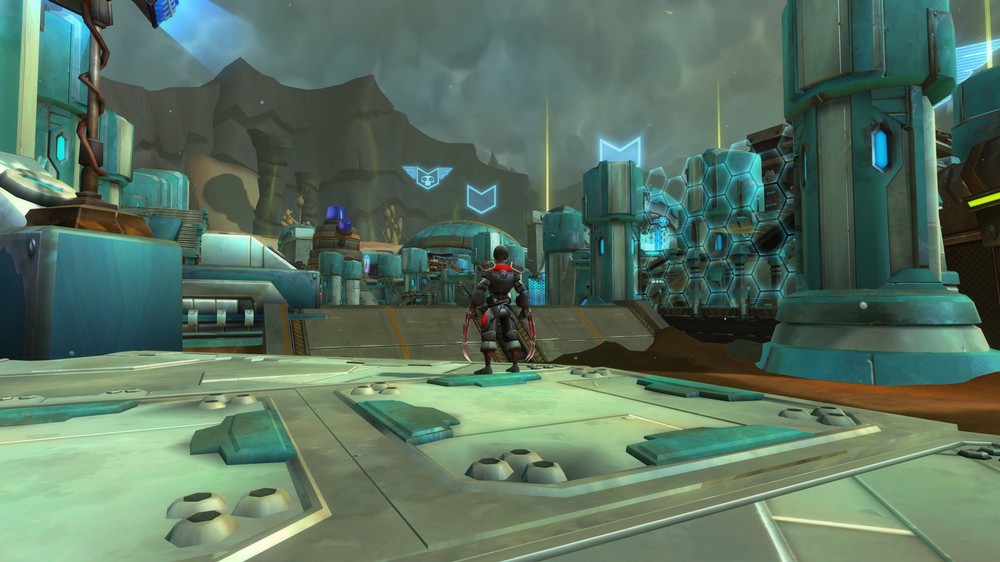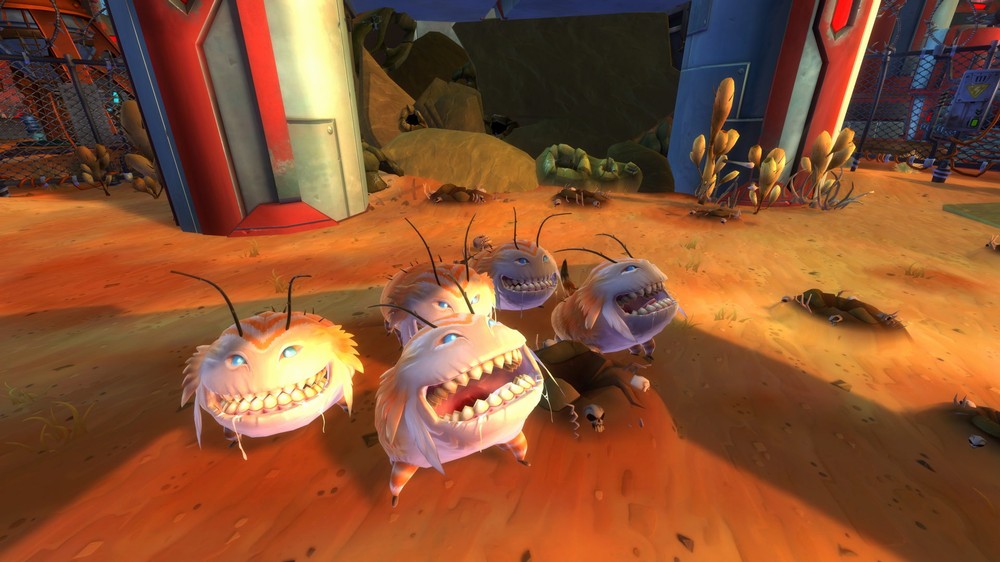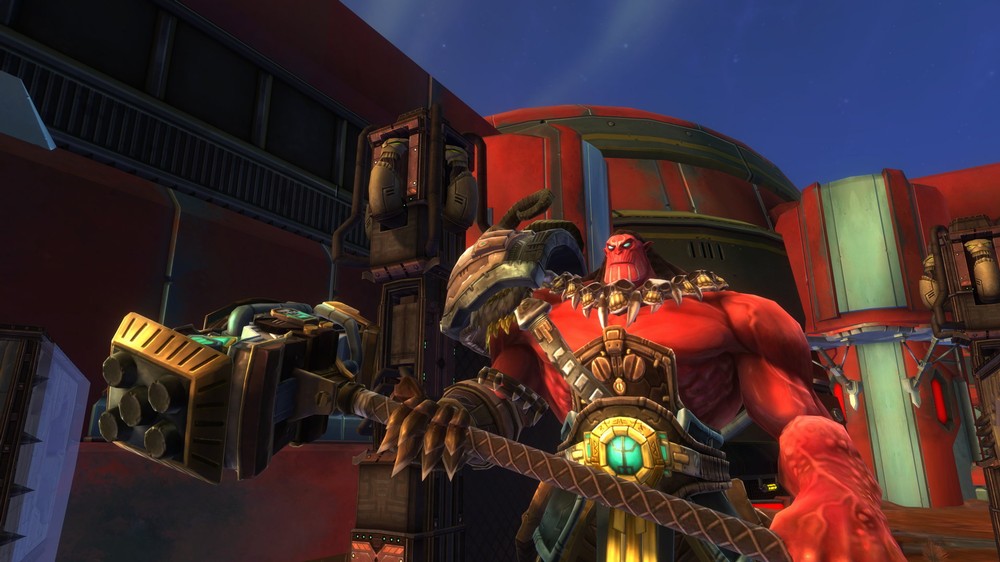Wildstar’s been out for almost a month, giving gamers a chance to explore Nexus and learn the secrets of the Eldan. Game Chronicles got the chance to talk to Chad Moore, Creative Director at Carbine, about what goes into creating narrative content and making creative decisions on a new MMORPG, as well as some lore trivia, and a question that couldn’t be answered.
Game Chronicles: What kind of compromises had to be made to make everything consistent in Wildstar? It’s a huge game with a lot of content, but its narrative tone and style are a lot more on the mark than some other MMOs out there. It seems like there must have been something left on the floor, or special effort put towards everything was in line with what you wanted to present.
Chad Moore: I think the compromises that we made, in general, we didn’t have to make a lot of content compromises, because of tone or design, but I believe that the biggest compromises we ended up having to make from a narrative standpoint are just because of the nature of an MMO. Ultimately, it’s challenging to tell a traditionally structured story in what ends up being an inherently non-linear game. Beyond the first fifteen minutes of gameplay, we don’t control, at any point, what direction you go, what content you experience. And so, because of that, it can be difficult to tell a story that’s cohesive, in the same way a novel or a single-player RPG is cohesive.
So, I think, those have been the biggest challenges for us. How can we get players bought into not just our game, but our overall universe, and ultimately into the bigger story of things that’re happening on Nexus, and not compromise what’s cool about an MMO, the total freedom to experience whatever content you want. Any compromises we’ve had the story side have been just because of the inherent nature of an MMO.
GC: Are there any specific challenges about presenting the lore with any degree of depth to the player that never opens the lore window? There’s a huge amount of information in the game, and there are things that you can pick up on from play, even without paying special attention to it.
CM: I think for a player who’s just not interested in reading quest text, or opening the lore window, there’s just a level of detail they’re going to miss. That said, I think we do a lot of work in our game, in our zones, our dungeons and adventures, using what we call visual storytelling.
Let’s say you come into an area and there’s this giant robot in an excavation site. So, if you don’t read anything at all, what you’re probably getting is, you’re on the legendary planet of Nexus, these guys were digging stuff up, and now there’s a robot on a rampage. I think, just on a base level, I think we work very hard to make sure the environments players are questing through, are telling story, not just of what’s happening in this region, but of what’s happening on the entire planet.
I think one of the bigger things we do is, we have avenues for storytelling that don’t require you to stop or watch a cinematic. We have Datacubes, fully voiced research notes left behind by the Eldan. When you click on them, you start to hear a snippet of what was going on in this area when the Eldan were here. What I like is, it lets you keep moving, keep enjoying the gameplay without having to stop.
We try whenever possible to tell stories that way. Stories that aren’t getting in the way of players who just want to grab things and get back into the gameplay. As a general rule, almost all of our deep storytelling is what we call opt-in. If you’re a player who really likes lore, there’s tons and tons of it out there, but you’ve got to decide to dig in. Quests might have an extra dialogue node to tell you about character motivation, or the Galactic Archives, part of your lore tab, let you go in at any time to read about a particular creature, a particular NPC, or a world group. So, players who enjoy that can dig deep, but for players who just want to play, we try to have vehicles for storytelling that don’t get in the way of playing.
GC: I love that stuff. I was really excited to see how everything worked. Now, when you’re building a new IP, and you have to make everything from scratch, how do you make the initial decisions? Are the design of the world, and the design of the races based on specific player interests, or is there something else you use as a launching point for your initial creative work?
CM: In terms of the visual designs for the player races, what we tried to do is to present a broad range of character types, in terms of visuals and archetypes, so that any kind of player can probably find something that resonates with them. So, on the Dominion side, we have the humans, the Cassians. But then we have our robots, the Mechari. They’re sort of like our James Bond-meets-The Terminator archetype. Then we have the Chua, who are these little psychopathic rodents. Much smaller, sort of creepily-cute, and that resonates with a certain type of player. As we were developing the lore, what was really important is that we had a really strong variation between the races that would resonate with whatever sort of player logged into the game.
And so, from there, once we had those visual landmarks, how we developed the stories were determined by the factions. So, for the Dominion, we had this powerful empire, and you’ve got the Mechari, who’re spies, hunting down enemies of the empire, and the Chua, who’re technologists who build all the cool weapons and spaceships, and the Cassians, who’re the leaders, and the Draken, who’re this warlike race. And that covers most of the important things within that faction, so we did that for both sides. So what you have in the end is this balance of visual archetypes, but also social and cultural archetypes within each faction. It gives the broadest range of choice, not just from a faction standpoint, but from a player race standpoint. It’s a two-pronged approach but I think, ultimately, it was successful.
GC: Absolutely. Just a month out from release, there’s so many people identifying really strongly with a given race, so many arguments in chat about what race is the best race. It’s hit a strong vibe for a lot of people.
CM: Yeah. And I think the other thing that was really important for me, from a lore standpoint, is having this strong conflict between the two factions that’s kind of irreconcilable. I like the idea that these two groups are never going to hold hands and group up. Or even have a temporary truce. I know some people like that sort of thing, but I like the idea that, no matter what’s going on, if a Dominion guy sees an Exile guy, they’re going to drop everything and go at it. There’s something kind of compelling about that.
So, that was one thing that was really important. But, also the individual stories of the races tie directly into the conflict. Each one of the races has a specific reason why the bigger conflict matters, why they care so much about it. It’s not just because they’re part of the group, each one of them has deep-seated motivations that make the conflict between the two factions even more important. So, that was another thing we really focused on as we developed the races, the reasons they cared about the conflict that drives the game.
GC: Yeah. Like, in World of Warcraft, every expansion ends with some reason for the Alliance and Horde to team up. I like the idea of that not being the narrative saw the game keeps coming back to.
CM: Yeah, when you pledge your allegiance to a faction, people relate. They see their character in that light. It’s a really awesome choice, and it’s more awesome when you make it mean something in the game. When it’s there’s not Terrible Event #762 that causes everyone to set aside their differences and work together. I just don’t really like that kind of storytelling. (laughter) Talk to me in five years and see if I’ve been able to hold my ground on that, but for now, that’s where I’ve planted my flag in the sand.
GC: We’ll see if every expansion starts with a hero getting corrupted.
CM: (laughter) Right.
GC: Oh, a friend wanted me to ask. Given how much Wildstar draws on pulp tropes, is there going to be a Hollow Earth? Or a Hollow Nexus, I guess.
CM: I’d love to answer that question. But I don’t think I’m going to be doing that today.
GC: Fair enough! Branching off that a little, what sort of things led you to design the world like you did? When I heard it was a sci-fi game, I expected something more built up and Star Wars-y, but it’s got this fantasy-western aesthetic with some sci-fi around the periphery. What informed that when you were making the game?
CM: The simplest point, to start that discussion is, when we first started talking about what became Wildstar, even back then there were quite a few fantasy MMOs. Obviously, there was World of Warcraft, but Ultima Online, Everquest, they’re fantasy games. We knew we wanted to do something a little bit different, but we also saw the value of having certain touchstones from fantasy, right?
Our warrior having a sword felt cool. The name itself: Warrior. It just felt right. Whenever it made sense, we decided to hang on to certain things, because they felt right. What that resulted in is, we have this unique and complex mix of fantasy and science fiction elements, and it’s one of the things that makes Wildstar unique. We didn’t fall into the science fiction trap of making things so different, so alien that they’re not relatable. We tried to hit the right balance so, even though it’s a sci-fi universe with other planets and alien technology, there’s those comfortable touchstones that keep you grounded in our game.
So, just to answer the science fiction versus fantasy question, that was where we started. In terms of the theme and the tone, it took us quite a while to get to where we are today in terms of Wildstar’s story and themes. What really defines what it is about our story is the idea of Nexus, this legendary world out beyond the fringe, beyond the known regions of space. There’s the question of what happens when someone finds a legendary place like this, or like Atlantis. One of the coolest things that sort of fell out of that story is that, if this place has never been seen, then that makes it a wild, unexplored frontier.
Those themes, whether they’re in literature of film, are obviously very popular. The idea of the old west, with expanses of unexplored lands and vicious creatures, and beautiful landscapes and hostile natives, all of those things that characterize stories of the old west. I think those things just fit into the story of Wildstar, and we started to really embrace what’s cool about that. The name itself has overtones of the wild west genre. Some of our marketing, our music, a lot of the storylines resonate with those themes. It was one of the more unique things that came out of development of the show. A lot of us liked Firefly, its take on the science fiction genre, and having some similarities to that was exciting for us. When it’s been appropriate, we really reflect that in our design and storytelling.
GC: I think a place where the game represents the feeling of frontiers in a really interesting way is that every zone has multiple biomes. It’s something I don’t really see in that many MMORPGs.
CM: That was something from the very early days of our development, that was a big focus. Like, this entire zone might have the same name, but if players are going to spend, sometimes, dozens of hours just in one particular zone, you get tired of seeing the same visual themes over and over. In all of our zones, it’s a conscious, deliberate choice to make these vastly different biomes, and then those biomes have vastly different world groups and stories. It’s an attempt to keep things fresh within the zones, and try to avoid zone fatigue. I think it’s been very successful.
GC: Absolutely. It’s one of my favorite parts of the game. Do you mind if I ask some picky nerd questions? Like, the traditional terrible Comic Con questions about inconsistencies or whatever.
CM: Go right ahead.
GC: Awesome. First, is there some kind of narrative around death in the game? Like, I know Holocrypts get mentioned in some of the ambient dialogue, but I wasn’t sure if there was some kind of secret of Nexus related to resurrection technology or something.
CM: (laughter) You know, it’s funny that you ask that question. I literally just sent off an email to some of our designers about this question, so I’ll give you the same answer I gave them:
There are some things in games that’re just game mechanics, and death is one of those things. Like, it happens, you know you’re going to be resurrecting the player, so trying to explain that in a way that’s somehow consistent, for not just you, but for every character in the game, it’s sort of a slippery slope. So, we decided a long time ago that there’s just no specific lore concerning the Holocrypt. We attached a voice and some personality to it, since it’s something that you experience all the time.
As much as we can, for those things that happen all the time in our game, we try to vary up the experience a little bit. Dying is never fun, but we try to add a little bit of levity, so you can wonder, oh, what’s the Holocrypt going to tell me this time? But, yeah, there’s no actual detailed lore or justification as to why you keep appearing at this holocrypt.
GC: Huh. I didn’t realize that was the voice of the Holocrypt, like how the Transmat has a voice. I always associated it to the level up voice, assumed it was just the voice of the narrator.
CM: It’s funny. I don’t know if people have made this connection, but the voice of the Transmat is actually the voice of the Caretaker.
GC: Oh! I didn’t put that together, but I did think they sounded similar.
CM: So, we don’t show him, but the idea is the Caretaker is always out there, and still trying to fulfill his original programming, to maintain and preserve all the things on Nexus. And we have the taxi, who has a voice, and the level up is our in-game narrator, who also shows up in the zone synopses. Wherever we can, we try to infuse a little bit of that Wildstar personality to keep players smiling and having fun.
GC: Is there an actual reason, aside from it needing to be true, that the Gambler’s Ruin and the Dominion fleet are both in orbit around Nexus, but not constantly fighting, or bombarding the surface?
CM: That’s a good question, and one we actually have a specific reason for. The reason there’s not orbital bombardments – for the Dominion for sure, but also for the Exiles, to a degree – is that it’s almost the holy land. At least for the Dominion. It holds a lot of value for the Exiles as well, as they study what happened to the Eldan and try to take advantage of this technology.
So it’s not that they don’t fight, and there’s not wars happening, but as for large-scale destruction, weapons of mass destruction, or orbital bombardments, those are things neither faction engages in because they don’t want to destroy what could end up being extremely valuable knowledge or technology.
In terms of the two sides, how we describe it is each arkship is on opposite sides of the planet. We do show that the Dominion sometimes tries to board the ship and attack. We don’t show this in the content, but there are probably space battles happen, where each side is trying to establish their territory in orbit. We don’t think people should assume things are completely hands-off, but at least in our mind, there’s still some reasons for why one of the Arkships hasn’t been destroyed, or why there’s not rampant destruction on Nexus.
GC: Awesome. And, one last thing: Is there a large delay between when Nexus is discovered and the game actually starts? Because there’s lore about the past events in Gallows, and things like the Dominion cities that’re immediately very built up.
CM: So, the way I describe it is, the Arkships arriving is when the vast majority of the population from both sides is showing up. But from a timeline standpoint, Nexus is discovered about five to seven years before the beginning of the game. There are definitely people who came here much faster, though, and started to build settlements.
It’s kind of a funny thing, because people – at least people who do housing – see the speed at which things are built. It doesn’t take super long to build walls and houses using the technology that Protostar and the factions have. Some of how some settlements are more built up is a factor of how they have this technology, and some is a factor of how long people have been there while the player was on the Arkships.
GC: Okay, cool. I think that taps me out. Thanks for talking to me today.
CM: Awesome, man. Nice to talk to you.


